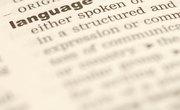Most students can speak English just fine, so it can be incredibly frustrating to have to learn why we use the words that we do. No wonder so many people dread English class! English grammar is filled with complex rules, different forms, and even more complex exceptions to those rules. Elementary school children are taught the basics of the eight parts of speech, such as nouns and adjectives, and how to construct a complete sentence. However, even college graduates sometimes have a difficult time immediately recognizing and distinguishing between a nominative pronoun and an objective pronoun.
Pronoun Use
A pronoun is a word that takes the place of a noun or another pronoun in the english language. For example, instead of saying, "Holly finished her homework," you might replace the noun "Holly" with the pronoun "She," saying instead, "She finished her homework." Pronouns keep written and spoken language less repetitive: "Jim noticed the sink was still dripping when he turned it off," as opposed to "Jim noticed the sink was still dripping when he turned the sink off." Pronouns are not as specific as nouns. "It" can refer to any number of things, not just direct objects. Care must be taken to use pronouns properly as to not mix up reflexive pronouns, demonstrative pronouns, relative pronouns, and subjective pronouns.
Nominative and Objective
In language, a nominative generally refers to the subject of a sentence, which is the performer of the verb in the sentence. For example, in the sentence, "The dog ran," "dog" is the nominative because it's the performer of the action verb "ran." An objective refers to a recipient or object of a verb or preposition. In the sentence, "Bill threw the ball," "ball" is an objective noun because it is the recipient of the verb "threw."
Nominative Pronouns
A nominative pronoun serves as the subject of a sentence or clause. For example, in the sentence, "Susan seems very tired today," "Susan" is a noun that is demonstrating the state of being tired. When "Susan" is replaced with the pronoun "she," then "she" becomes the subject of the sentence. Other examples of common nominative pronouns are "I," "he," "we," "they, "you" and "it.". “I” being a personal pronoun.
Objective Pronouns
While nominative pronouns demonstrate a state or action, objective pronouns are the objects of an action or preposition, or object of a preposition. If someone were asked, "Where are the cookies?" he might reply, "I ate them." In the latter sentence, "them" is the objective pronoun. It has taken the place of the noun "cookies" and is the object of the verb "ate." Someone on a date might explain to a waiter, "She is with me." In this sentence, "me" is the object of the preposition "with.". These linking verbs also an example of an indirect object they are referring to.
Types of pronouns
The nominative and objective forms are usually specific to their use. "I," "he," "she," "we" and "they" are all examples of nominative pronouns because they can be used only in the nominative case. "Me," "him," "her," "us" and "them" are all objective forms. Other pronouns, such as "you" and "it," can be either nominative or objective, not a possessive pronoun.
Misuse and Confusion
It’s easy mix up objective case pronouns with others like possessive case and nominative. Perhaps the most common problem with nominative and objective pronouns is mistaken usage. Though many say, "Tom and me watched a movie," the nominative pronoun "I" should be used instead: "Tom and I watched a movie." Hyper-correction can be a problem as well. Some use the nominative when it isn't called for: "The party is for my husband and I." The objective pronoun "me" is the correct object of the preposition "for."
Related Articles
References
Writer Bio
Stephanie Parker holds a bachelor's degree in elementary education, and a Master's of Education in library science. She currently works as a school librarian and spent six years teaching Prekindergarten and Head Start.









